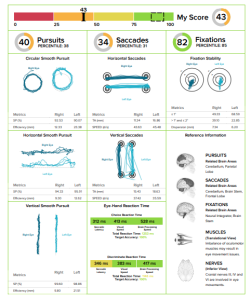Intricate Work Comp Concussion Case
3/9/2023 Concussion Case Study
30 y.o. Female sustains a concussion while holding a child during a co-treat speech therapy session. As the child extended to avoid cueing from another therapist, our patient extended to avoid him and her chair fell back resulting in contact with her head against the wall.
This patient attempted to continue working without limitations for 2 weeks after being diagnosed with a concussion. Due to severe symptoms of blurred vision, headache, nausea, dizziness, sleep dysfunction, difficulty remembering, difficulty concentrating she was put on workman’s compensation and referred to Dr. Fitzgerald & Associates for concussion rehabilitation. Her baseline post-injury Right Eye Assessment is as follows:

Began with a total symptom score of 32/96 upon beginning concussion rehabilitation. The patient began treatment utilizing the eyes with syntonic light frequency therapy to balance the autonomic nervous system. We were then able to progress to peripheral vision exercises, taking the strain off of her lack of convergence. As her symptoms progressively decreased, she was able to tolerate eye hand coordination exercises, depth perception exercises, and all exercises forcing the eyes to team together with all movements. She was cleared to return to work by her work comp MD for 4 hours per day, multiple days per week. From 1/4/2023 to 1/27/2023 she attempted this schedule, while also doing concussion management around various work hours. This caused stress to her visual and emotional systems due to using her computer to document therapies done with children under duress.
Due to the consistent symptom score of about 24/96, she began our Multi-Sensory Reset Therapy (Pinnacle Program) for 1 hour per day x 12 days in a row; discontinuing work until further notice. This helped to continue to balance her autonomic nervous system, continue to work toward her eyes working effectively and efficiently together, and decrease her emotional response to stressful situations. She continued concussion management with an Athletic Trainer 3x per week upon completion of this 12-day program.
Two months after her initial visit, her Right Eye Assessment looks like:

This demonstrates that the patient now needs an increased amount of vestibular integration to reduce symptoms.
Utilization of compression, weighted lei, and going shoes off to increase proprioception have improved vestibular responses. She also benefited from sound wave therapy, whether it be standing on a vibration plate or utilizing sound waves over both ears. As of 3/8/2023, she arrived at rehabilitation with a total symptom score of 11 and left at a 4/96…! She has improved sleep quality, zero blurry vision, and is able to perform body weight exercises and walking based cardio exercises without symptom provocation.
She has been back to work for 1 week at 4 hours per day, every morning, with a maximum of 2 patients per day to allow ample documentation time before going home. The patient reports no symptom change or increase with work stimuli now. Below is her Right Eye Assessment from 3/6/2023:

This patient still has some working to do in order to return to her normal, or new normal after concussion. However she has demonstrated significant improvement in every trajectory of concussion.
Intricate Work Comp Concussion Case Read More »

